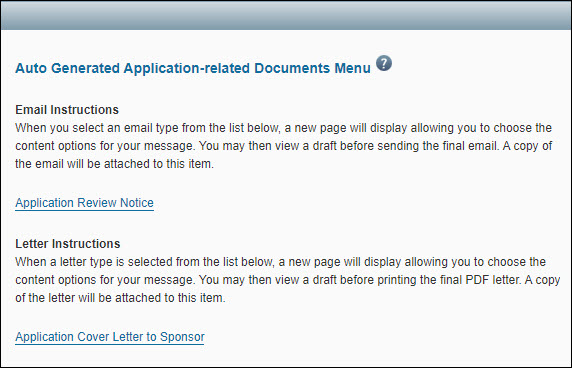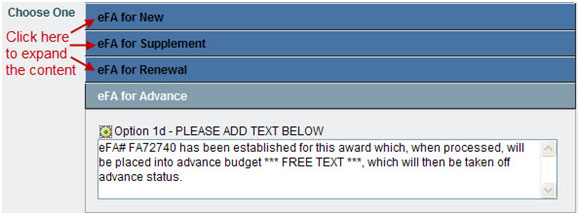Each Funding Action has a status that can change based on manual action by the user. The status reflects where the FA is in the whole grant lifecycle from In OSP to Processed.
A Funding Action may have one of the following statuses:
- In OSP: Initial status for a new FA. OSP staff can edit FAs with this status.
- Approved: When you click the Approve link in the left navigation, the status of an FA changes from In OSP to Approved. An FA must have an Approved parent application and be in a Cycle before you can approve it. OSP staff can still unlock and edit an FA with this status.
- In GCA: When you click the Send to GCA link in the left navigation, the status of an FA changes from Approved to In GCA. An FA must have a status of Approved, and not be on Hold, before you can send it to GCA. OSP staff cannot edit an FA with this status.
- Returned By GCA: An FA has this status when GCA sends it back to OSP to add or correct information. OSP staff can unlock and edit an FA with this status. When GCA returns the item, the system assigns it to the Prepared By person (or to the Failover Team if the person is no longer OSP staff). NOTE: You can personalized your Tasklist to help you identify these returned transactions.
- Re-Sent By OSP: An FA has this status after you edit an FA that has a Returned by GCA status and resend it to GCA. OSP cannot edit an FA with this status.
- Duplicate: An FA has this status when you click the Mark as Duplication link. You must enter the number of the existing FA this FA duplicates to assign this status.
- Denied: An FA has this status when you click the Deny link in the left navigation.
- Processed: An FA has this status after GCA has fully processed the FA and notified campus. OSP cannot edit an FA with this status.
To view status history
If you have any questions about the status of a funding action, you can check its Status Page for the details.
The following table describes the columns on the Funding Actions Tasklist and the type of information included in each column. The columns are listed alphabetically.
| Tasklist Column |
Description |
| Approval Date |
Date the FA changed to Approved status |
| Assigned To |
Initially, the OSP staff person who creates the FA |
| Assigned To Date |
Date the FA is assigned to a different person |
| Budget Number |
Added by GCA staff when they process the FA |
| Cycle # |
Cycle the FA is associated with |
| Date Created |
Date the FA is created |
| Date Received |
Note: no value is currently mapped to this column |
| FA Amount |
Funding amount entered by OSP |
| Group |
Auto-assigned based on team/org code matrix for OSP, and GCA relationships |
| Has Attachments? |
Icon (blue page with folded corner) displays if FA has any attachments |
| On Compliance Hold? |
Icon (yellow octagon with red letter C) displays if FA is on Hold for compliance |
| On Non-Compliance Hold? |
Icon (yellow octagon) displays if FA is on Hold for non-compliance reasons |
| Org Rcvg Funding |
Name of Organization Receiving Funding; inherited from parent eGC1 |
| Org Rcvg Funding Code |
Code of Organization Receiving Funding; inherited from parent eGC1 |
| Originating Sponsor Name |
Inherited from parent eGC1 |
| Originating Sponsor Award Number |
Entered on FA |
| Parent Item |
Unique number of the eGC1 that is the FA’s parent |
| PI Name |
Name of Principal Investigator; inherited from parent eGC1 |
| Short Title |
Also known as the Budget title; inherited from parent eGC1 |
| Sponsor Award # |
Inherited from parent eGC1 or entered on FA |
| Sponsor Name |
Inherited from parent eGC1 |
| Sponsored Program Activity Type |
Inherited from parent eGC1 |
| Status |
System generated; initial status upon creation is In OSP |
| WIAP |
Value (YES or blank) for the WIAP Terms & Conditions question |
You can personalize your tasklist to display only the information you’re interested in tracking. For example, you can select which columns display and the order of the columns, among other things.
For messages that you often send to campus and sponsors, SPAERC provides a set of automatically generated documents (AGD) for you to customize.
A document is either an email which the system will send or a letter created as a PDF for printing. The system captures a copy of the communication and automatically attaches it to the related item.
For many of the documents, specific data from the item pre-populates email addresses, dates, sponsor names, proposal titles, and other information. You can edit this pre-populated information.
Available Auto Generated Documents
Applications
- Application Review Notice: use this email to send review comments to the Principal Investigator, Administrative Contact, Pre-Award Budget Contact, and eGC1 Preparer.
- Application Cover Letter to Sponsor: print this PDF-formatted letter and mail it to the sponsor in support of the application. The PDF file includes the UW letterhead. The eGC1 Campus Comments (entered in SAGE) display for reference at the top of the customization page. (They also appear on the Control Sheet.)
Funding Actions
- Notice of Award: use this email to send information about the award received to the Principal Investigator, Administrative Contact, Pre-Award Budget Contact, and eGC1 Preparer.
- Request for Activation Notice – fellowships: use this email to notify the PI of a fellowship award and request the PI to complete the Activation Notice.
- Research Agreement Acknowledgement: use this as a cover letter for the sponsor’s agreement sent to ensure the PI understands the terms. This is for industry sponsors.
- Sponsor Document Cover Letter: send this to the sponsor with the signed copies of the agreement.
Admin Actions
- SFI Compliance Notification: send this email to the PI about SFI disclosure for a budget extension.
- Sponsor Document Cover Letter: send this letter to the sponsor with the signed copies of the agreement.
Subawards
- Email Notification: send this email to the PI with attachments concerning the subaward.
- Notice to NIH: send this letter to NIH about the financial disclosures of the PI and the subrecipient.
- Cover Letter: send this letter to the subrecipient with the subaward agreement.
- Bilateral Modification/Amendment: send this email to the subrecipient with the appropriate attachments.
- Unilateral Modification/Amendment: send this email to the subrecipient with the appropriate attachments.
- Bilateral Subaward: send this email to the subrecipient with the appropriate attachments.
- Unilateral Subaward: send this email to the subrecipient with the appropriate attachments.
Create an Auto Generated Document
- From within an open item, click the Auto Generated Documents tab.
- The page will open and display a list of email and/or letter choices.
- To select the email message or letter you wish to create, click its link.

The email or letter draft will display. You can edit most of the suggested content.
Note: You will need to add content wherever you see three asterisks on either side of a description, such as *** FREE TEXT ***.
Document Section Types
- Pre-populated values such as the PI’s email address or the sponsor’s name and address. You may edit them if necessary.
-
- Paragraphs which may be complete as given, or may require the addition of specific information such as a date or amount of award.
For example, the Subject or Opening as shown in the following image.

- Choose One options allow you to select one section of content by clicking the radio button; you may edit the content. By default, some information is not displayed. To expand these sections, click the blue boxes.

- Choose Any options allow you to select one or more content sections by checking the box(es); after you select a section, you may edit the content.

Finalize and Send an Auto Generated Document
- After you have selected and edited the content, click the View Draft Email or View Draft PDF button to review the customized document. It will open in a separate window.
- You can close this window, make any necessary changes, and review the draft again, as needed.
- To create the final version of the document, click the Send Final Email or View Final PDF button.
- For email messages, you will need to confirm that you want send the email and attach it to the permanent record. The system will send the email message to the recipients and a copy to your email account. The final email will display in a separate window. A confirmation message will display in the main window.
- For letters, the final version displays as a PDF in a separate window. You may print the PDF and mail it.
View the Attached Copy of the Auto Generated Document
- For Applications, the document copy is attached in the Documents Uploaded by OSP section of the Attachments & Routing questions page. Campus user can view these attachments.
- For Funding Actions and Admin Actions, the system adds the document copy to the attachments area of the item. You may need to expand the attachments section to see the list of documents. Campus user can view these attachments in the Related Documents section of the application’s Attachments page.
Note:
- If you create another auto-generated document of the same type, the system will add it as a separate attachment.
- You cannot delete an attachment, but you can update it, depending on the item’s status
Administrative Actions—usually referred to as Admin Actions–record a type of action or adjustment to an application or an award in SPAERC.
When you first create an Admin Actions, it is an “unidentified” or generic action (AAs). You then change the Admin Action to one of the following specific actions:
- A Non-Award Agreement (NAA) records a generic agreement not pertaining to funding.
- A Pre-Award Notification (PAN) records a change to the proposed project before the sponsor awards funding.
- A Funding Action (FA) indicates that the sponsor funded the proposal and records funding specifics about the award.
- A Post-Award Change (PAC) records changes to the project after the sponsor awards the funding.
- A Close Out (CO) records the tracked activities to terminate a project upon completion of the research.
Use a Funding Action (FA) to transmit award information to Grant and Contract Accounting (GCA) when the sponsor funds a proposal. GCA uses the information provided in the FA for account setup and award distribution.
The Funding Action includes general information about the project, account setup, and budget details, among other details.
When GCA completes setting up the account, the system sends an email notification, with a PDF of the FA, to the PI, eGC1 Preparer and Contacts, and select reviewers. This notification lets the research team know they can now submit charges against the account.



